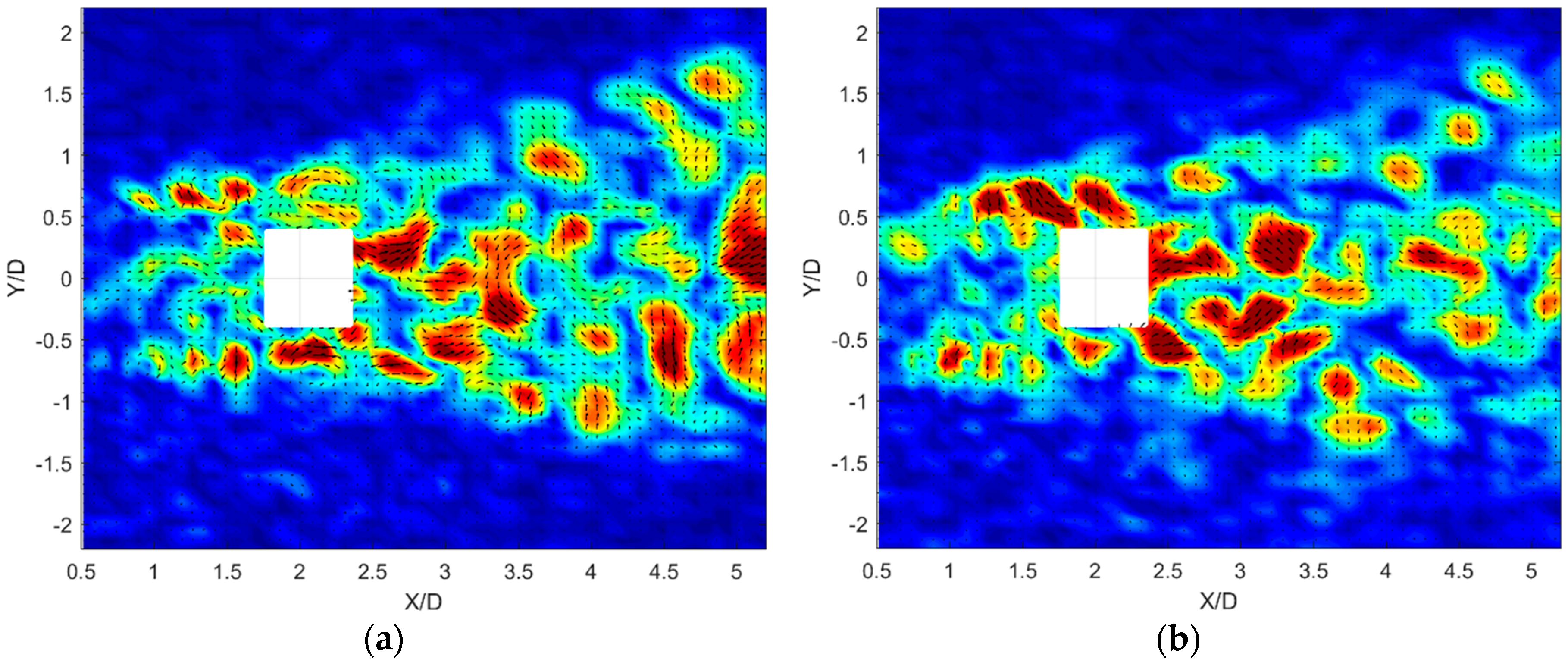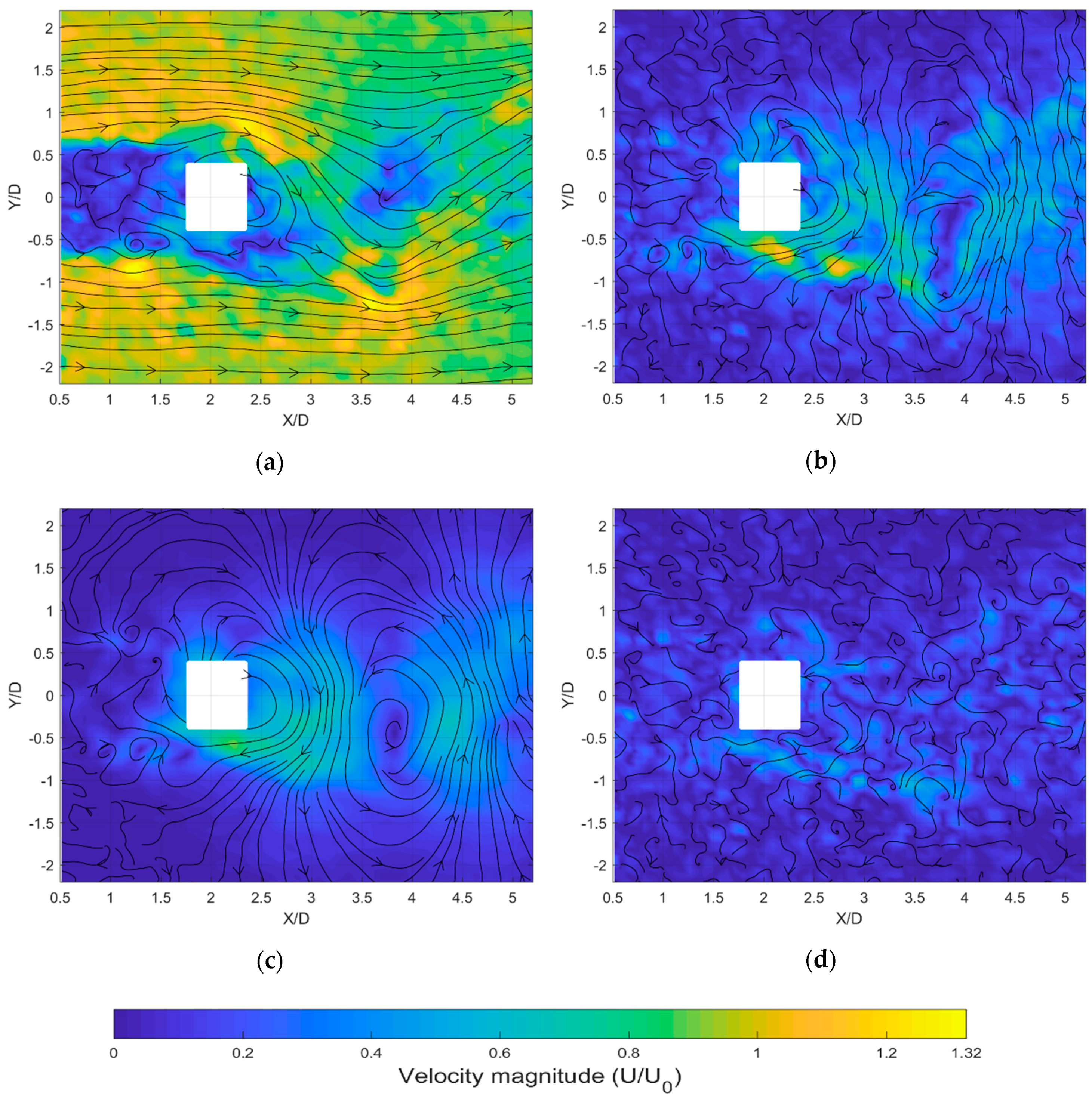The literature presented thus far highlights the criteria commonly used for the selection of POD modes. The methodology presented in this paper provides an alternative approach to defining which POD spatial modes are associated with the coherent motions, and which represent flow features representative of turbulence.
The methodology is underpinned by considering a pair of repeated experiments under similar conditions. In this situation, it would be expected that when considering flow statistical measures, the two sets of results would be highly similar, albeit with some stochastic variation evident in the comparison of instantaneous flow fields. Further, performing decomposition, POD, independently on each set of results would result in similar spatial modes representing the coherent motions; with a similar number of POD modes comprising the turbulent energy content of the flow for each experiment. Therefore, by the comparison of these independently calculated POD spatial modes from each result set, it may be deduced that those spatial modes that appear in both sets contain coherent flow information. In addition, the stochastic nature of turbulence suggests that there should be no similarity in the spatial modes, other than the number of modes and the total flow energy proportion that they represent.
2.3. Identification Methodology
Firstly, it should be determined that the dataset is of sufficient size (N) to adequately represent the flow features using half of the time instances captured (N/2), ordered randomly. This may be effectively assessed by considering the convergence of statistics between the two half-datasets (set A and set B) and the full dataset such as a comparison of the rms velocity component distributions.
Figure 6 demonstrates parameters that may be used to assess the suitability of the number of snapshots considered. Here, the order has been randomised and the mean velocity distribution for a given number of snapshots is compared with the population mean and the velocity error,
, the difference between population mean velocity at each point and the mean velocity at each point for a given number of snapshots, is evaluated by a PDF.
Figure 6a presents the PDF for 1536 (i.e., half of the dataset) snapshots error from which the standard deviation may be extracted.
Further, if this process is repeated from 1 up to the number of available snapshots, the trend may be plotted as in
Figure 6b. It can be seen that after a modest number of snapshots, the error is less than 0.01 magnitude, and by 1536 it is approximately of magnitude 0.001 which in this case is deemed to be acceptable. In addition to this check, the velocity RMS
Figure 6c for a given number of snapshots can be seen to converge after approximately 1000 snapshots. Therefore, it is deemed that using half of the dataset, 1536 snapshots may sufficiently represent the full dataset.
Whilst here it has been determined that N/2 vector fields are sufficient, this may not always be the case; this would depend on many factors including the frequency of both the large-scale flow structures and the measurement.
Once it is determined that both set A and set B are statistically similar to each other, and to the full dataset, POD analysis may be performed on each set independently. Following decomposition according to Equation (2), two sets of POD spatial modes should exist, allowing a comparison between them.
Following conventional POD processes, the energy contained within each mode may be calculated according to Equation (3) and examined. This is calculated for set A and B and presented in
Figure 7. Both sets provide a similar distribution of energy with the first two modes for each containing the majority of flow information. This indicates that much of the large-scale, dominant flow structures are captured by these modes.
It should be noted that during the application of the POD approach, the ensemble average is first subtracted. This is because it would otherwise appear as the first, most energetic mode, sometimes referred to as mode 0 in cases where it is not removed prior to POD analysis. Therefore, the decomposition is only carried out on the fluctuating velocity component. The mean is later recombined in the reconstruction.
As previously discussed, one method for determining the cut-off mode between coherent and turbulent motions is to consider the energy knee-point, which using
Figure 7 would suggest mode 3. However, there may be subsequent modes which still contain coherent motions, but at lower energy. Considering the first three modes only,
Figure 8 presents the associated spatial modes obtained from each of the two sets. Firstly, there is clear evidence from
Figure 8e,f that visually similar spatial modes are obtained for the third mode in both sets, which would indicate the likelihood of good correlation and therefore imply that these modes are representative of coherent motions and therefore should be considered as such.
Examination of both the energy content,
Figure 7, and the spatial mode distributions,
Figure 8, for modes 1 and 2 suggests that there is a pairing between them. Pairs of modes often exhibit very similar energy as is the case here, when their pairing is descriptive of oscillatory behaviour. By exploring the temporal coefficient information, this pairing can be further characterised. Firstly,
Figure 9a presents the first two modes plotted against each other, revealing the pairing dependence of these two modes. Considering the frequency content of the temporal coefficients in
Figure 9b reveals strong evidence that the oscillatory pairing is actually that which is responsible for the same frequency peak at approximately 2 Hz identified earlier. For comparison, the frequency content of mode 3,
a3 is also plotted, exhibiting similar frequency energy distribution across the frequency range, outside of the 2 Hz peak.
Now, considering higher order modes, which are not expected to be representative of coherent motions,
Figure 10 presents POD spatial mode 30 for each set. In contrast to those modes presented in
Figure 8, there is no clear visual similarity between the two POD spatial modes. This indicates that the two presented modes are not representative of coherent motions. However, if the size of the structures represented in each mode is considered, these are of similar character and of an expected magnitude for turbulent length scales in this flow. Further, the region in which the POD spatial mode structures are contained is within the central, turbulence containing region, with insignificant contributions in the free-stream area.
Similarity between two flow fields—or in this case spatial modes represented as velocity vectors—may be achieved by considering two-point statistics, specifically the cross-correlation function.
The generalized equation for the cross-correlation function between any two-points separated by the vector,
r and time
τ may be defined as:
where
ui and
uj are the velocity components for correlation. It is common to use a simplified form of Equation (6) for correlations at the same point in time, spatial velocity correlation (SVC,
τ = 0) or correlations performed at the same point in space, autocorrelation function (ACF,
r = 0). For the application presented, it is the cross-correlation of POD spatial modes that is to be considered, thus no true time association exists. However, for the purposes of the comparison, it is convenient to consider the two desired POD modes for comparison as two time-steps at the same spatial location, leading to the following equation:
where subscripts A and B define the POD mode from set A and its corresponding (or other as appropriate) POD mode from set B respectively.
Each mode number is considered in turn from mode 1 through to the total number of spatial modes available in each of the two datasets. For each spatial mode, the surrounding +/−5 modes may also be compared. For example, S
A = 10 will be compared using Equation (7) to modes S
B = 5:15. This is to account for any minor re-ordering of POD modes which can occur when two or more consecutive POD modes have similar energy and therefore may be slightly re-ordered during the calculation of eigenvalues. This leads to a set of (11) correlation values for each mode considered, as represented in
Figure 11. It should be noted that the absolute correlation should be considered as it is possible for two POD analyses of nominally the same velocity fields to produce an equal but opposite velocity spatial mode, with the corresponding reversed temporal co-efficient.
It can be seen in
Figure 11 that for the majority of modes in set A, the strongest correlation occurs with the corresponding mode in set B as one would expect. However, there is evidence of some mode re-ordering, for example, for the modes 18 and 22 where the strongest correlation occurs with a mode +2 and −2 respectively, showing evidence of a pair with similar energy whose order has been swapped. Following this approach, the most significant correlation value is extracted for each mode in set A to obtain
Figure 12. For the purposes of selecting a cut-off mode, it has been deemed appropriate to smooth the trend to easier identify the point at which POD spatial modes have poor self-correlation. The reasoning is that in turbulent fields, with similar sized features, spikes of increased correlation may be observed for a single spatial mode. In addition, in consideration of correlation in
Figure 12, it is necessary to define a value below which it is considered poor correlation. The introduction of this new parameter,
R, allows tuning of the coherent structures to be included in the low order model. In this case, 0.6 is selected as the threshold to poor correlation.
From
Figure 12, it is apparent that poor correlation (defined here as less than 60%) occurs at greater than 23 POD modes for the datasets presented. Therefore, it follows that the first 23 modes contain high levels of coherent information and should therefore be considered when POD filtering is applied to these velocity fields. Subsequent analysis of coherent structures and their characteristics may be carried out on a reconstruction using the first 23 POD modes. Analysis on stochastic turbulence characteristics of the flow should be carried out on a reconstruction using the remaining 24-1536 POD modes (otherwise known as the residual fields). At this point, it would be possible to instead only consider the modes which have a significant correlation.
The final step of the technique is to recombine the POD spatial and respective temporal co-efficients to obtain coherent and turbulent velocity fields. The cut-off POD mode should be used (in this case 23) for the reconstruction of coherent fields of each dataset, SA and SB. The two datasets may then be recombined, taking note of the randomization carried out earlier in the presented methodology. This is particularly important if subsequent frequency analysis of coherent structures is to be carried out.
The resulting decomposed flow field provides a coherent and incoherent part of each instantaneous velocity field as presented in
Figure 13a,b respectively. The original, raw velocity field is also presented in
Figure 13c. The effect of reconstructing the velocity field using only the POD modes associated with coherence is a smoothed velocity distribution which still contains the larger, bulk features without the small-scale structures—this is visually evident in a direct comparison between
Figure 13a,c.
The entire process is summarised as a flowchart in
Figure 14 which should be followed for implementation with any new dataset. It is possible to omit some stages such as the check for convergence, if desired.



























